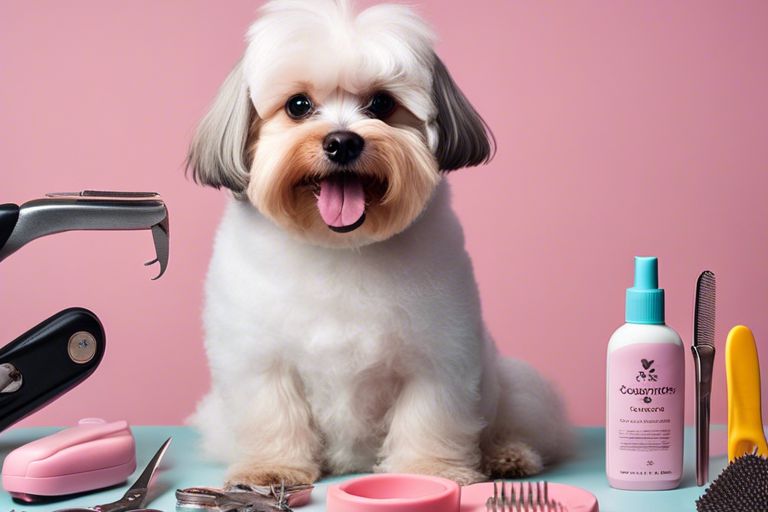Onychiotomy, or keeping your small dog’s nails trimmed, is an essential part of their grooming routine. Overgrown nails can cause discomfort and even health issues for your pet, so it’s crucial to find the best method for maintaining their nails. I’ve researched and tried various techniques, and I’m here to share my expertise on the matter. Trimming your small dog’s nails can be a daunting task, but with the right approach, it can be a simple and regular part of your pet care routine.
Key Takeaways:
- Regular Trimming: Keeping your small dog’s nails trimmed on a regular basis is crucial to prevent overgrowth and potential health issues.
- Proper Tools: Invest in quality nail trimming tools specifically designed for small dogs, such as small clippers or a nail grinder, to ensure a safe and effective trimming process.
- Professional Help: If you’re unsure about how to trim your small dog’s nails or if they have black nails that make it difficult to see the quick, seek professional help from a veterinarian or a professional groomer.
Understanding Your Dog’s Nails
Some dog owners may not realize the importance of keeping their small dog’s nails trimmed. Long nails can cause discomfort, difficulty walking, and even lead to more serious health issues if left unattended. Understanding your dog’s nails and how to properly care for them is essential in maintaining their overall well-being.
Anatomy of a Dog’s Nail
When it comes to understanding your dog’s nails, it’s important to know the basic anatomy. A dog’s nail is comprised of the hard outer shell, known as the nail, and the inner quick, which contains blood vessels and nerves. It’s crucial to trim the nails without cutting into the quick, as this can cause pain and bleeding. Understanding the structure of your dog’s nail will help you trim them with confidence and precision.
Identifying the Quick in Different Nail Colors
Identifying the quick in your dog’s nails can be challenging, especially when they have dark-colored nails. The quick is easier to see in light-colored nails, appearing as a pinkish area within the nail. However, in darker nails, it may be more challenging to identify. One way to gauge the quick in dark nails is to look at the underside of the nail and determine where the quick ends. Taking extra care with dark nails is important to avoid cutting into the quick.
Preparation for Nail Trimming
Assuming you have already made the decision to trim your small dog’s nails at home, the next step is to prepare for the task at hand. Proper preparation will not only make the process easier for you, but it will also help ensure the safety and comfort of your furry friend.
Gathering the Right Tools
When it comes to trimming your small dog’s nails, having the right tools is essential. You will need a pair of high-quality, sharp nail clippers specifically designed for small dogs. Additionally, having a styptic powder or gel on hand is important in case you accidentally cut the quick of the nail and cause bleeding. These tools can typically be found at your local pet store or online, and it’s worth investing in good quality products to make the process smoother and less stressful for both you and your dog.
Creating a Calm Environment
It’s essential to create a calm and comfortable environment for both you and your dog before beginning the nail trimming process. Find a quiet, well-lit area where you can comfortably sit with your dog. Consider laying a towel or blanket on the floor to provide a non-slip surface for your dog and to catch any nail trimmings. Playing soothing music or offering treats can also help to relax your dog during the process. Remember, a calm environment can make a significant difference in the success of the nail trimming session.
Accustoming Your Dog to Nail Trimming
Before diving into the nail trimming process, it’s important to acclimate your dog to the experience. Start by gently handling your dog’s paws on a regular basis to get them used to the sensation. You can also try lightly pressing on their nails to simulate the feeling of the clippers. This will help desensitize your dog to the experience and make the actual nail trimming process much smoother. Positive reinforcement, such as praise and treats, can also be used to create a positive association with nail trimming.
Techniques for Safe Nail Trimming
For safe nail trimming, it’s important to use the right techniques to ensure you don’t accidentally hurt your small dog. There are a few different methods you can try, and the best one will depend on your dog’s temperament and comfort level. Some dogs are more sensitive about their paws, so it’s important to be patient and gentle. If you’re having trouble with this, you can find some helpful advice here.
Step-by-Step Nail Trimming Guide
When it comes to trimming your small dog’s nails, it’s important to have a clear plan in place to ensure that the process is as safe and stress-free as possible. Here’s a simple step-by-step guide you can follow:
| Step 1 | Prepare the tools you’ll need, including a pair of dog nail clippers and styptic powder in case of bleeding. |
| Step 2 | Find a comfortable and well-lit area where you and your dog can relax and focus on the task at hand. |
| Step 3 | Gradually get your dog used to the clippers, allowing them to sniff and inspect the tool before use. |
| Step 4 | Gently hold your dog’s paw and trim small amounts of the nail at a time, avoiding the quick. |
| Step 5 | Reward your dog with treats and praise throughout the process to reinforce positive behavior. |
Tips for Dealing with the Quick
Dealing with the quick can be a nerve-wracking experience, as cutting this sensitive area can cause pain and bleeding. To prevent accidental injury, it’s important to be cautious and attentive. Use sharp nail clippers to make clean, precise cuts and always keep styptic powder on hand in case of bleeding. Perceiving the quick as a pinkish area in the nail, you should avoid cutting into it at all costs.
Regular Maintenance Schedule
Keeping a regular maintenance schedule for your dog’s nail trimming is crucial to their overall health and well-being. I recommend checking your dog’s nails at least once a month and trimming them as needed. By keeping their nails at a safe length, you can prevent discomfort, pain, and potential injury from overgrown nails.
Alternatives to Traditional Trimming
Unlike traditional nail trimming, there are a few alternatives you can explore to keep your small dog’s nails trimmed. These methods can be a great solution if your dog is resistant to regular nail trimming, or if you are looking for different options to keep their nails at a safe length.
Nail Grinding Tools
If you have a small dog who is particularly sensitive to nail trimming, nail grinding tools can be a game changer. These tools use a rotating sanding band to gradually grind down your dog’s nails, which can be less intimidating for both you and your furry friend. It’s important to choose a high-quality, low-noise grinder specifically designed for small dogs to avoid any discomfort or accidents. Be sure to follow the manufacturer’s instructions carefully and introduce the tool to your dog gradually to help them acclimate to the sensation.
Utilizing Professional Grooming Services
If you find it challenging to trim your dog’s nails at home, seeking the help of a professional groomer can be a worthwhile investment. Groomers are experienced in handling small dogs and can efficiently trim your dog’s nails with precision and care. They have the proper tools and training to ensure a safe and comfortable experience for your pet. While this option may come at an additional cost, the peace of mind in knowing that your dog’s nails are being expertly trimmed may be well worth it.

Best Way to Keep Your Small Dog’s Nails Trimmed
Now that you know the importance of keeping your small dog’s nails trimmed, it’s important to find the best method for doing so. I have found that the best way to keep my small dog’s nails trimmed is by using a quality pair of nail clippers specifically designed for small dogs. Regularly inspecting your dog’s nails and being proactive about trimming them when necessary will also help prevent overgrowth and potential health issues. Additionally, if you are unsure about how to properly trim your dog’s nails, consult with a professional groomer or your veterinarian for guidance. Remember, keeping your small dog’s nails trimmed is essential for their comfort and overall well-being.
FAQ
Q: What is the best way to keep my small dog’s nails trimmed?
A: The best way to keep your small dog’s nails trimmed is to regularly trim them using a pair of dog nail clippers. It’s important to trim your dog’s nails to prevent them from becoming overgrown and causing pain or difficulty walking.
Q: How often should I trim my small dog’s nails?
A: Small dog’s nails should be trimmed every 3-4 weeks. However, the frequency of nail trimming may vary depending on your dog’s activity level and the surfaces they walk on. Regularly checking your dog’s nails will help you determine when they need to be trimmed.
Q: Are there any alternatives to trimming my small dog’s nails?
A: Yes, there are alternatives to trimming your small dog’s nails. You can use a dog nail grinder to gradually file down the nails instead of cutting them. Additionally, taking your dog for regular walks on rough surfaces can help naturally wear down their nails. Consulting with a professional groomer or veterinarian can also provide alternative solutions for keeping your small dog’s nails trimmed.


